Japan's Official Development Assistance White Paper 2013
(2) Health, Welfare, and Population
A large number of people living in developing countries do not have access to the basic health services that are usually available in developed countries. At present, the lack of hygienic environments has led to the annual loss of 6.9 million children under the age of five due to infectious diseases, undernutrition, diarrhea, and other health ailments. (Note 2) Moreover, over 280,000 pregnant women lose their lives every year without getting emergency obstetric care by skilled birth attendants like obstetrician, gynecologist and midwives. (Note 3) Furthermore, the world’s population continues to increase, and it is leading to further poverty, unemployment, food shortages, delayed education, and environmental deterioration in poorer countries with higher rates of population growth.
From the perspective of solving these problems, the international community has been working together to achieve the health-related MDGs (Goal 4: reducing child mortality, Goal 5: improving maternal health, Goal 6: preventing the spread of HIV/AIDS, malaria, and other infectious diseases) since 2000. The deadline to achieve the MDGs, the year 2015, is approaching; however, the delay in the progress is especially in low income countries is making it difficult to achieve these goals. Moreover, even in the countries in which the indicators have improved, low-income families are still unable to access medical services since they cannot afford to pay the medical costs. Thus, disparities in health within a country are posing an additional challenge. In addition, in recent years there is a need for addressing new health issues, such as malnutrition including overnutrition, non-communicable diseases such as diabetes and cancer, and increasing aging populations. In order to address such increasingly diversified health issues in each country and region in the world, it is important to achieve “Universal Health Coverage (UHC)” to ensure that all people obtain the health services they need without suffering financial hardship when paying for them. (See this page)
<Japan’s Efforts>
●Health and Medicine
In May 2013, Japan formulated “Japan’s Strategy on Global Health Diplomacy.” This strategy positions global health issues as a priority for Japan’s diplomacy, and sets forth policies for the private and public sectors to work together in order to improve global health. At TICAD V in June, Prime Minister Shinzo Abe announced this strategy in the opening speech of the conference, and expressed Japan’s determination to contribute to the promotion of UHC through which all people of the world can receive basic health care services, based on the principle that improving the health of all people is indispensable to realize human security. It was also announced that Japan will provide ¥50 billion and provide support for human resource development of 120,000 people in the field of health in the next five years.
For more than 50 years Japan has been providing health insurance systems such as the universal health insurance system, and has become a society in which people enjoy the best health and the longest life expectancy in the world. Under this strategy, Japan will pursue such efforts as the effective implementation of bilateral assistance, strategic collaborations with global initiatives of international organizations, etc., the enhancement of domestic capabilities and the fostering of human resources.
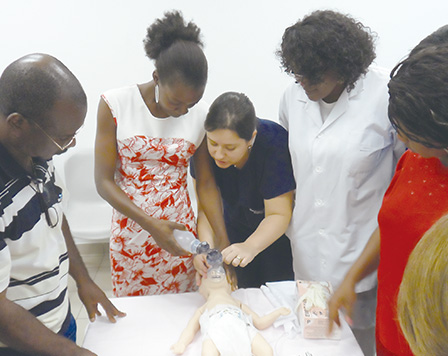
Neonatal resuscitation training in Angola, provided by a specialist from the University of Campinas in Brazil. Japan is providing support through triangular cooperation. (Photo: Kayo Omachi / JICA Angola Field Office)
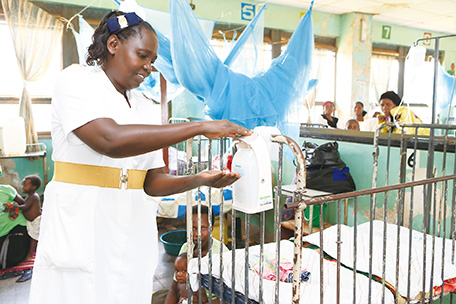
A nurse disinfecting her hands using alcohol disinfectant dispenser attached to a bed in pediatric ward in the Gombe Hospital in Uganda. (Photo: Kentaro Taketani / Saraya Co., Ltd.) (See “Stories from the field”)
Over the past years, Japan has attached great importance to global health, which is directly related to human security. Japan has led international discussions on health system* strengthening. At the G8 Kyushu-Okinawa Summit in 2000, infectious diseases were taken up for the first time as a major item on the agenda of the Summit. This led to the establishment of new funding mechanisms such as the “Global Fund to Fight AIDS, Tuberculosis and Malaria” in 2002.
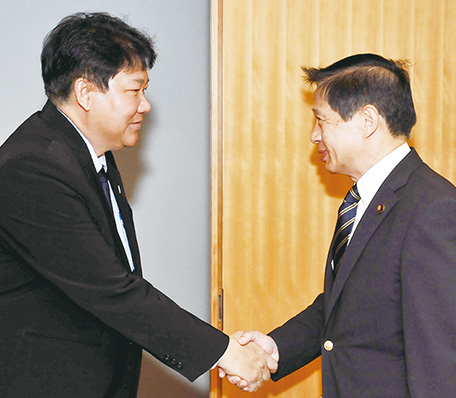
In October 2013, Parliamentary Senior Vice-Minister for Foreign Affairs Norio Mitsuya had a meeting with Dr. Pe Thet Khin, Minister for Health of Myanmar.
At the July 2008 G8 Hokkaido Toyako Summit, the “Toyako Framework for Action on Global Health” was released under agreement by the G8 nations, asserting the importance of strengthening health systems. Moreover, at the G8 Muskoka Summit (Canada) in June 2010, under the Muskoka Initiative that aims to strengthen support for maternal and child health, Japan announced that it would additionally provide up to ¥50 billion, approximately $500 million, over the next five years from 2011.
In addition, Japan presented the “Japan’s Global Health Policy 2011-2015” at the September 2010 UN Summit on the MDGs, and announced that Japan would provide $5 billion of aid (including a contribution of up to $800 million to the Global Fund to Fight AIDS, Tuberculosis and Malaria (the Global Fund) in the coming years from 2011), for the purpose of contributing to the achievement of the health-related MDGs. The three pillars of Japan’s global health policy are; (i) maternal, newborn and child health; (ii) measures against the three major infectious diseases* (HIV/AIDS, tuberculosis, and malaria); and (iii) response to public health emergencies, including polio and new strains of pandemic influenza (See this page for details regarding infectious diseases). Especially, Japan is striving to provide assistance based on the EMBRACE* for maternal and newborn child health, which are the most off-track to meet the targets in Ghana, Senegal, Bangladesh, and other countries. This strategy encourages mutually complementary collaboration with international organizations and other development partners to enable developing countries to tackle and achieve the health-related MDGs. Moreover, Japan aims to save approximately 430,000 maternal lives and 11.3 million children’s lives across partner countries in cooperation with international organizations and other development partners. In particular, by strengthening measures against HIV/AIDS, tuberculosis and malaria in making further financial contributions to the Global Fund and Japan’s bilateral assistance, Japan is working to provide effective assistance to reduce 470,000 deaths by AIDS, 990,000 deaths by tuberculosis, and 3.3 million deaths by malaria across partner countries, in cooperation with other development partners.
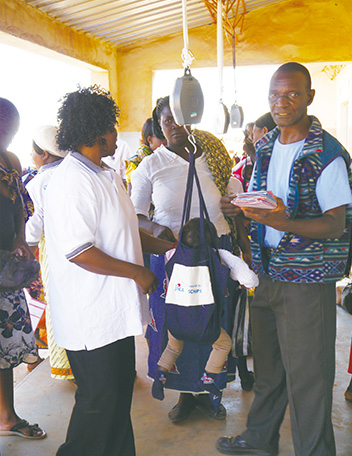
The project for Strengthening Community-based Child Health Promotion System in Urban Areas in Zambia. Weighing and growth monitoring of infants is conducted in this project. (Photo: Hisayuki Inaba)
Glossary
- *Health System
- Health system includes mechanisms for the preparation and maintenance of government systems, the improvement of healthcare facilities, the optimization of the supply of pharmaceuticals, the accurate understanding and effective utilization of healthcare information, financial administration, and the acquisition of financial resources, as well as the development and management of personnel to operate these processes and provide services.
- *The three major infectious diseases
- Refers to HIV/AIDS, tuberculosis, and malaria. Worldwide deaths from these diseases total to approximately 3.6 million. The spread of these infectious diseases significantly impacts society and the economy, and is a factor that inhibits national development. Accordingly, it is a serious threat to human security, and a global issue that must be addressed by unified efforts of the international community.
- *EMBRACE(Ensure Mothers and Babies Regular Access to Care)
- Assistance for strengthening the system of providing comprehensive maternal and child health care. It aims to provide continuum of care throughout the pregnancy, from pre-pregnancy (including adolescence and family planning), antenatal maternity, postnatal, newborn, to infant period, viewing these periods in a single timeline by creating linkages between family, community and primary/secondary/third healthcare facilities. Specifically, such care includes checkups for pregnant women, birth assistance, immunization, improvement in nutrition, human resource development for maternal, newborn and child health, development of facilities with the capacity to provide emergency obstetric care, strengthening of system of governments and medical institutions, utilization of maternal handbooks, and postnatal checkups.
Note 2: Source: UN “The Millennium Development Goals Report 2013”
Note 3: Source: WHO, UNICEF, UNFPA, and the World Bank “Trends in Maternal Mortality: 1990 to 2010”
●Nine French-speaking African countries
Human Resource Management in Health Sector for French Speaking West and Central African Countries 2
Training Course in Japan (Training and Dialogue Program) (2012 – 2013)
During the TICAD V, Japan announced its intention to support the achievement of universal health coverage (UHC). The goal of UHC is ensuring that all people can use the appropriate promotive, preventive, curative, and rehabilitative health services they need without suffering financial hardships.
Many African countries have a shortage of healthcare workers providing health and medical services. The overconcentration of healthcare workers in urban areas, the outflow of healthcare workers to other countries, and deterioration in quality are also among the grave challenges facing the countries.
This training was conducted for trainees to learn in depth about Japan’s initiatives, e.g., for the fostering and deployment of healthcare workers as well as for the retention of healthcare workers in remote and rural areas. The objective was to get trainees to draw on the knowhow they acquired during this training to implement initiatives that will help resolve the issues confronting their own countries.
This training was designed for government officials managing human resources in the health sector in the nine French-speaking African countries of Benin, Burkina Faso, Burundi, Côte d’Ivoire, Democratic Republic of the Congo, Niger, Mali, Togo, and Senegal. In five years from FY2009, more than 70 people took part in this training and conducted lively discussions with trainees from countries having the same challenges.
One of the outputs of this training course was the establishment of “the network for the human resources for health in francophone African countries (Reseau Vision Tokyo 2010, in French)” in 2012, at the proposal of the trainees. With the cooperation of the National Center for Global Health and Medicine in Japan, the wisdom of francophone Africa was exchanged and accumulated through Japanese assistance. Many spillover effects emerged, including the creation of a document that outlines the general situation of the human resources in the health sector in each country, and the holding of technical exchanges concerning the human resources information system for health (iHRIS) and presentations at international conferences.
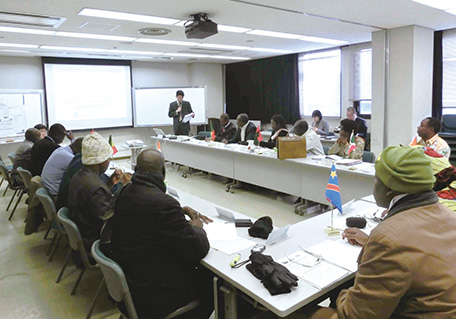
A lecture during the training in Japan (Photo: National Center for Global Health and Medicine)
●Assistance for the persons with disabilities
As stated in the ODA Charter, Japan pays due attention to the socially vulnerable including the persons with disabilities when drafting and implementing ODA policies. Policies for the persons with disabilities covers a number of different fields, including welfare, health and medical care, education, and employment. Japan has utilized the techniques and experiences Japan has accumulated in these fields through ODA and NGO activities to promote measures for the persons with disabilities in developing countries. For example, Japan has been providing suitable assistances to various local needs, such as promoting barrier-free transportation including railroads and airports, building vocational training and rehabilitation facilities for the persons with disabilities, and providing minibuses for their transportation.
Additionally, through JICA, Japan has conducted wide-scale technical cooperation efforts to build capacity for organizations and personnel offering assistance to the persons with disabilities in developing countries. Included among these efforts are the acceptance of trainees from developing countries and the dispatch of JOCV and a variety of experts, including physical and occupational therapists and social workers.
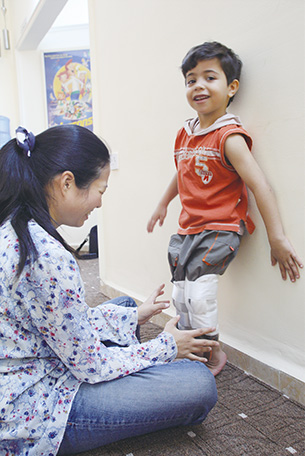
Ms. Yokomatsu, a Japan Overseas Cooperation Volunteer, provides rehabilitation for disabled children in Aqaba, Jordan. (Photo: Hironobu Kubota)
●Myanmar
Project for Supporting Social Welfare Administration - Promotion of Social Participation of the Deaf Community
Technical Cooperation Project (December 2007 – Ongoing)
Public services necessary for the social participation of the disabled are not adequate in Myanmar. One of its major challenges is ensuring that hearing-impaired people (deaf community) who use sign language as their first language are able to obtain necessary information and access adequate services, including education and health services. In daily life, teachers at schools for the deaf and family members of the deaf provide simple sign language interpreting. Oftentimes, however, they are unable to provide interpreting at conferences, courts, hospitals, and education settings, making it urgent to train people capable of sign language interpreting (sign language interpreters).
This project is designed to make sign language more accessible, as well as to train people that teach sign language to sign language interpreters (sign language teachers). By doing so, the project aims to facilitate the social participation of the deaf community – one of the last groups among the disabled people in Myanmar to receive assistance.
In Phase I, which commenced in 2007, public servants, deaf persons, and teachers at schools for the deaf collaborated and decided on a standard sign language, developed teaching materials, and carried out activities to make sign language more accessible. Through these activities, sign language teachers were fostered. Also, the skills of public servants were improved to be able to establish social welfare administrative services that meet the wishes of people with disabilities.
In Phase II implemented since August 2011, the sign language teaching skills of sign language teachers have been enhanced through various activities, including training for sign language teachers as well as workshops for learning the importance of sign language interpreting, both conducted in Myanmar, and through trainings in Japan. Today, sign language teachers have become instructors and are teaching to increase the number of sign language interpreters.
(As of August 2013)
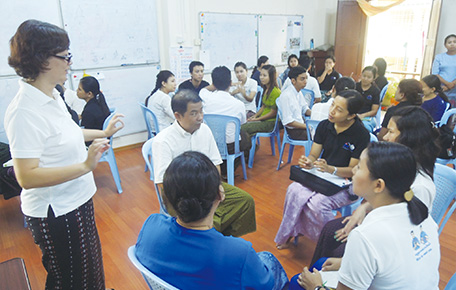
Future sign language interpreters receiving training (Photo: JICA)
